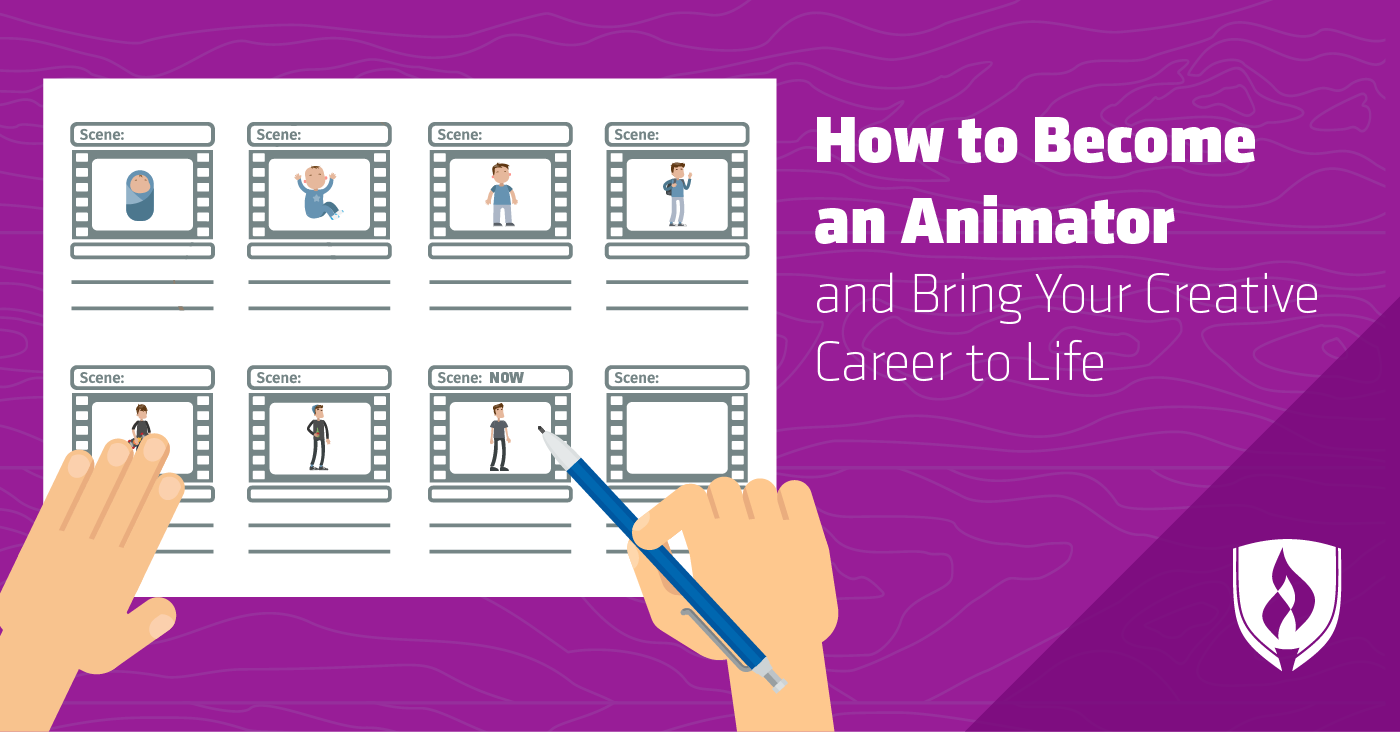
Animation is such a brilliant vehicle for storytelling that it’s easy for people to never really consider what goes on behind those flickering pixels. Getting caught up in the magic, movement and color—who is going to be thinking about what happens on the other side of the screen? As it turns out: you are!
If you love design and animation, the process of how the work comes together is just as fascinating as the work itself. But there’s a process to consider even before that—the steps you’ll need to take to become an animator in the first place.
In this article, we’ll outline what makes an animation career appealing as well as the steps you’ll need to take to make this creative career a reality.
Why become an animator?
Though it might seem like a lofty career aspiration, animation is actually a thriving industry with lots of options and solid job opportunity. The Bureau of Labor Statistics (BLS) writes that consumers demand more realistic video games, movie and television special effects, and three-dimensional movies will continue driving employment opportunity for animators.*
“Animation has never been more popular than today,” says animation voiceover icon Bob Bergen. “Every major studio has a thriving animation department. There are 24/7 networks devoted to animation. Animation is one of the oldest forms of media entertainment, and with everything new in technology, it’s still going strong with no end in sight.”
5 Steps to becoming a professional animator
Is an animation career in your future? The following steps will lay out what you can expect to do along the way.
Step one: Assess your aptitude
Animation isn’t for everyone. You’ll need certain skills and traits to be successful. While nearly anything can be learned over time with enough instruction and practice, you’ll still want to do a little honest self-inventory and compare with what employers expect of animators.
Animators, like many other professionals, will need to have a mix of technical and “soft’” skills to excel in their careers. Organizational ability, creativity, teamwork and communication skills might seem like obvious requirements, but they’re listed for a reason. Animators often work closely as part of a team and receive feedback from stakeholders who might not have a creative background and need these skills to work effectively. After all, there’s not much use for brilliant animators if they can’t take direction, work well with others or explain their vision.
Moving beyond soft skills, there’s plenty for animators to master on the technical side of things. Our analysis of over 6,306 multimedia designer and animation job postings found the following skills and competencies were most commonly required:**
- Adobe® Creative Suite® (including Photoshop®, Illustrator® and After Effects®)
- Prototyping
- User experience (UX) / User Interface (UI) design and wireframing
- 3D modeling
- Video editing
Step two: Get educated
Once you have a handle on what’s expected of animators, the next step for most is to build their abilities through education. Employers typically require animators to possess a Bachelor’s degree, according to the BLS.* That lines up with our analysis of job postings, too—83% of the jobs postings we analyzed preferred applicants with a Bachelor’s degree.**
These degrees not only verify to employers that you have a well-rounded education, but they also ensure that you get important exposure to many facets of motion graphics and animation. For example, Rasmussen College’s Bachelor’s degree in Graphic Design with an Animation & Motion Graphics specialization includes courses on color theory, digital effects, the business of digital media, 3D modeling and portfolio development.
Your Bachelor’s degree should provide you with everything you’ll need technically to begin working in animation—along with other core graphic design skills and the theory to back them up.
Step three: Seek experience
While some students might find job opportunities without experience outside of school, Tom Geiser, president of Pickett Productions says internships are an important way for aspiring animators to transition from academia to the career world.
“Animation school projects are nice, but they don’t always translate in the real world,” Geiser says. “Try to get an internship—or freelance while you are in school. Practical job experience puts you miles ahead of the competition.”
If you can find a few opportunities to network at school and land an internship or a few low-budget clients who are willing to try your skills, you can develop a much stronger portfolio and resume.
Step four: Build your portfolio
As an animator, you aren’t going to be walking into a job interview with a scrapbook. Many animators create websites to showcase their best work, attract clients and impress employers. Your animation program should give you plenty of good direction in building a convincing portfolio, and you will most likely have a few projects to showcase there by the time you graduate.
Animation is definitely a “show me” career—the more work you can highlight and include, the better. Try to balance your portfolio with different animation styles and types of work. A robust portfolio with varied work samples will go a long way toward improving your employability.
Step five: Find a job
With a Bachelor’s degree, some internship or freelance experience and a strong portfolio, you will be well equipped to search for a job in animation. While it might not be what first springs to mind, many animators work outside of movies and advertisements. Our article, “Where Do Animators Work? 5 Options You Never Knew Existed,” outlines a few of the lesser-known animation employment options.
To make yourself as competitive as possible, Geiser advises new animators to gain more general experience. “Most seem to have experience in one aspect of animation or one software platform.” But if you branch out and try to learn another program, you’re more likely to have the right skill set.
“I think animation students, like other students, are unsure on how to sell themselves or accentuate the positives in their experience,” Geiser says. “I know it’s tough talking about yourself, but you will have to do it sooner or later.”
Are you drawn to animation?
If you were wondering how to become an animator, then you probably now know that the exciting world of animation isn’t all that far away!
These steps offer a birds-eye view of what it takes to become an animator. The good news is you’re well on your way toward completing the first step just by reading this article. As you make the move from self-evaluation to furthering your education, you’ll want to do your research and ensure you find a program that fits you and your needs well. If you’re ready to take that step, check out the Bachelor’s degree in Graphic Design—Animation and Motion Graphics specialization program page to learn more about what Rasmussen College has to offer.
*Bureau of Labor Statistics, U.S. Department of Labor, Occupational Outlook Handbook, [information accessed September 17, 2018] www.bls.gov/ooh/. Employment conditions in your area may vary.
**Burning-Glass.com (analysis of 6,306 animator job postings, Aug. 01, 2017 – Jul. 31, 2018).
Creative Suite, Photoshop, Illustrator, and After Effects are all registered trademarks of Adobe Systems.




